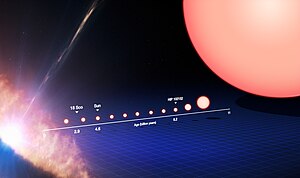HD 197027
It has an apparent magnitude of 9.15,[2] making it readily visible through a telescope but not to the naked eye.
The object is located at a distance of 255 light years but is approaching the Solar System with a heliocentric radial velocity of −44 km/s.
[5] HD 197027 has a stellar classification of G3 V, indicating that it is an ordinary G-type main-sequence star like the Sun.
[9] At an older age of 6.92 billion years, it spins with a projected rotational velocity of about 2 km/s.
[9] Since its measured properties of this star are very similar to those of the Sun, it has been considered a candidate older solar twin.
